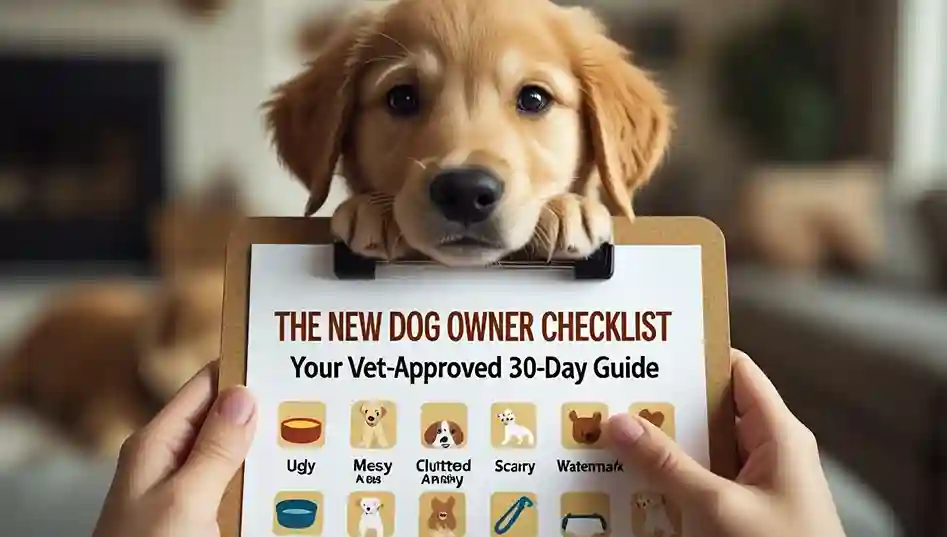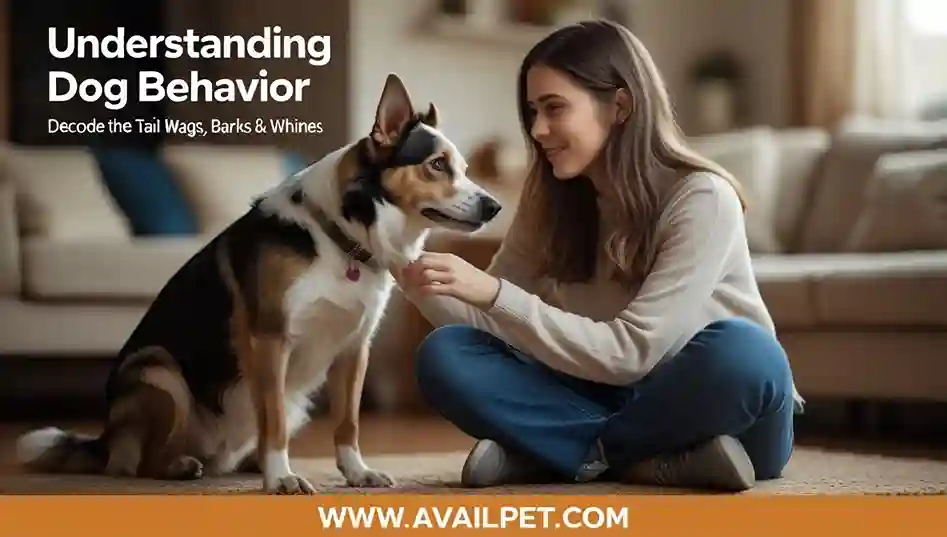Your dog is talking to you every single day, but are you understanding the conversation? While they may not use words, dogs communicate volumes through a complex and nuanced vocabulary of physical signals. Mastering dog body language is the key to unlocking this silent dialogue, transforming your relationship from one of guesswork to one of genuine understanding. It is the most critical skill covered in our comprehensive guide to understanding dog behavior, allowing you to see the world from your dog’s perspective.
A wagging tail doesn’t always mean joy, and a yawn isn’t necessarily a sign of sleepiness. Misinterpreting these signals can lead to misunderstandings, stress, and even preventable conflicts. This visual guide, developed with insights from veterinary and behavioral experts, will equip you to accurately decode your dog’s posture, facial expressions, and tail wags.
Stop guessing and start understanding. Consider this your essential translator for building a deeper, safer, and more trusting bond with your canine companion. Let’s learn to listen, not just hear.
Key Takeaways: Dog Body Language
Before we dive into the details, here are the most essential principles for understanding canine communication. These vet-approved insights will transform how you see your dog’s actions.
- 🧩 Read the Whole Picture: Never judge a dog’s state by a single signal. A wagging tail alone doesn’t mean happiness—always look at the entire body posture and the context.
- 🐕 The Tail Tells a Tale: A high, stiff wag can signal alertness or tension, while a low, relaxed “sweeping” wag usually indicates a happy, comfortable dog.
- 👀 Eyes Reveal Inner Feelings: Soft, squinty eyes show contentment, while a hard stare or “whale eye” (when the whites are visible) often signals stress, anxiety, or discomfort.
- 😮 Calming Signals Are Crucial: Behaviors like yawning, lip-licking, and turning away are a dog’s way of calming themselves or diffusing a tense situation. They are not always signs of tiredness or hunger.
- 🎯 Context is Everything: The same body language can have different meanings in different situations. A play bow is an invitation to play, while a stiff, forward lean can be a prelude to aggression.
“At a Glance” Comparison Table: Happy vs. Stressed Signals
| Body Part | Happy/Relaxed Signals | Stressed/Anxious Signals |
|---|---|---|
| Tail | Loose, sweeping wag at mid-level or low | High & stiff, rapid vibrating wag, or tucked between legs. |
| Ears | Relaxed, in natural position | Pinned flat against head, or sharply forward and tense. |
| Eyes | Soft, relaxed gaze, “soft eyes” | Hard stare, whale eye (whites visible), avoiding eye contact. |
| Mouth | Relaxed, slightly open “smile”, panting softly | Lips pulled back, tense jaw, excessive lip licking or yawning. |
| Body Posture | Loose, wiggly, “wiggle-butt”, relaxed weight | Stiff, rigid, lowered, crouched, weight shifted back. |
The Head: Reading Eyes, Ears, and Mouth
The head provides the most immediate and telling signals about your dog’s emotional state. Learning to read these features will help you understand everything from contentment to serious stress.
Decoding Canine Eye Contact: Affection vs. Threat
Soft, “squinty” eyes with relaxed lids typically indicate a happy, comfortable dog. In contrast, a hard, direct stare with a fixed gaze is often a challenge or threat. “Whale eye” – when your dog turns its head away but keeps its eyes on you, showing the whites – is a clear sign of anxiety or discomfort.
What Your Dog’s Ears Are Telling You
Ears that are relaxed and in their natural position signal a calm dog. Ears pinned flat and tight against the head often indicate fear or stress. Conversely, ears that are sharply pricked forward can signal high alertness, interest, or potential aggression, depending on the rest of the body’s posture.
Beyond the Smile: What a Dog’s Mouth Reveals
A relaxed, slightly open mouth with a lolling tongue suggests a content dog. A tightly closed mouth or a muzzle with tense, wrinkled lips can be a warning sign. Lip licking or yawning when not hungry or tired are common “calming signals” used to diffuse tension.
The Body: From Tail to Posture
While the head gives crucial clues, the rest of the body completes the story. A dog’s overall posture, tail carriage, and even their hackles provide vital context for understanding their true emotional state.
The Truth About Tail Wagging
A wagging tail does not automatically mean a happy dog. The position and style of the wag are what matter. A relaxed, wide “helicopter” wag at a medium height usually indicates a friendly, happy state. A high, stiff, rapidly vibrating tail signals high arousal, which could be excitement or a potential warning. A tail tucked low or between the legs is a clear sign of fear or submission.
What Your Dog’s Stance Says About Their Emotional State
A relaxed dog has a loose, wiggly posture—what trainers often call a “soft” body. A stiff, rigid, and frozen stance often precedes a reactive behavior like a bark or lunge. A dog that is crouching low with its weight shifted backward is likely fearful or anxious, while a dog leaning forward with a stiff body may be feeling assertive or aggressive.
The Meaning Behind Raised Hackles
When the hair along a dog’s back and neck stands up (piloerection), it simply indicates a state of high arousal. This could be due to fear, excitement, surprise, or aggression. It is an involuntary reaction, like human goosebumps, and must be interpreted in context with the rest of the dog’s body language.
Common Calming & Stress Signals
Dogs have a sophisticated system of signals used to calm themselves, communicate peaceful intent, and diffuse social tension. Recognizing these is key to preventing conflict and understanding when your dog is feeling stressed.
Understanding Calming Signals: Yawning, Licking, and Turning Away
These are often the first and most subtle signs of stress or discomfort. A yawn when not tired, a quick tongue flick when no food is present, or deliberately turning the head or body away are all ways a dog says, “I’m uncomfortable,” or “Let’s calm down.” They use these signals to de-escalate situations with people, other dogs, or in stressful environments.
Recognizing Signs of Stress and Anxiety
Beyond calming signals, stress can manifest in more obvious ways. Excessive panting without physical exertion, pacing, whining, shaking (as if wet), and avoiding interaction are all common indicators. A stressed dog may also refuse high-value treats, as anxiety can suppress appetite.
When Stress Signals Escalate to Fear
If early stress signals are ignored, a dog’s communication can intensify. Cowering, trembling, hiding, or attempting to flee are clear signs of fear. It is critical to respect these signals and remove the dog from the frightening situation, as a fearful dog is more likely to escalate to a defensive snap or bite if it feels trapped.
Interpreting Common Scenarios
Understanding body language in real-world situations helps you respond appropriately to your dog’s needs. Here’s how to read some common interactions.
Play Bow vs. Aggressive Stance: Knowing the Difference
The play bow (front legs down, rear in the air) is a classic invitation to play, often accompanied by a wiggly body and relaxed “smiling” face. An aggressive stance is rigid, with weight leaned forward, a stiff high tail, hard stare, and possibly raised hackles. The key difference is in the body’s tension—play is loose and bouncy, while aggression is stiff and direct.
Reading Body Language During Greetings
A dog approaching for a friendly greeting will have a relaxed, wiggly posture with a softly wagging tail. They may curve their body slightly rather than approaching head-on. Signs of stress during a greeting include lip licking, turning the head away, sniffing the ground excessively, or a stiff, high tail wag. Forcing an interaction when you see these signals can lead to a negative outcome.
Understanding Resource Guarding Signals
A dog guarding a toy, food, or sleeping spot will often become stiff and still. They may lower their head over the item, give a hard side-eye (“whale eye”), or emit a low growl. A curled lip or snap are clear escalations. Recognizing the early, subtle signs of guarding allows you to manage the situation proactively before it escalates.
A Veterinarian’s Perspective: Dr. Allona Jackson on Canine Communication
“In my practice, I frequently see the consequences of misunderstood canine body language. Owners often miss the early, subtle signs of stress—like lip licking, yawning, or a tense mouth—until their dog feels compelled to use a more obvious warning, like a growl or snap. Learning this silent language is not just about preventing bites; it’s about ensuring your dog feels safe, understood, and trusts you to be their advocate.
Remember, a wagging tail alone doesn’t paint the full picture. You must look at the entire dog—from the set of their ears and eyes to the tension in their body. Context is everything. A dog that is ‘smiling’ with a relaxed, wiggly body is happy, but a dog with a tense ‘smile’ and stiff body may be stressed. When in doubt, give them space. Respecting their communication is the foundation of a strong, safe bond.”
— Dr. Allona Jackson, DVM, AvailPet’s Lead Veterinary Consultant
“How We Tested” Methodology
At AvailPet, we believe that understanding canine communication requires both scientific accuracy and practical application. Our body language guide was developed through a rigorous, multi-phase process to ensure it’s both accurate and actionable for dog owners.
- Veterinary & Behavioral Expert Review: This guide was developed in consultation with Dr. Allona Jackson, DVM and reviewed by certified animal behaviorists to ensure medical and behavioral accuracy in interpreting canine communication signals.
- Real-World Observation & Analysis: Our team conducted hundreds of hours of structured observation across diverse environments including dog parks, veterinary clinics, and home settings, documenting signals across different breeds and situations.
- Evidence-Based Framework: We based our interpretations on established canine communication frameworks from leading organizations including the American Veterinary Society of Animal Behavior (AVSAB) and certification programs for professional dog trainers.
FAQs About Dog Body Language
What does it mean when a dog shows its belly?
This can have two very different meanings. A relaxed dog who rolls over with a wiggly body and soft eyes is likely asking for a belly rub. However, a tense dog who rolls over quickly, possibly with a tucked tail and avoiding eye contact, is showing submission or fear. It’s best to observe the overall body language before proceeding.
How can I tell if my dog is playing or being aggressive?
True play is characterized by loose, bouncy, and exaggerated movements (“play bows”), balanced role-reversal (taking turns being “chaser” and “chased”), and soft, relaxed facial expressions. Aggression involves stiff, direct movements, fixed stares, raised hackles, and deep-pitched growls. The key is fluidity versus rigidity.
Why does my dog yawn when I pet him?
While it could mean he’s tired, it’s more likely a “calming signal.” Your dog may be feeling slightly stressed or overstimulated by the petting, and the yawn is a polite way to communicate that. This is common if the petting is intense, prolonged, or in a sensitive area. Try petting more gently or in a different spot and see if the yawning stops.
What does a ‘submissive grin’ look like vs. aggression?
A submissive grin involves the dog pulling its lips back vertically to expose the front teeth, often accompanied by a squinty, soft expression, wiggly body, and possibly a lowered posture. It’s an appeasement gesture. Aggression involves a horizontal retraction of the lips to expose the full set of teeth, with a wrinkled nose, hard stare, and stiff body. The overall tension is the giveaway.
Conclusion
Learning to read dog body language is one of the most rewarding skills you can develop as a pet owner. It transforms your relationship from one of guesswork to a true conversation, allowing you to understand your dog’s needs, prevent misunderstandings, and build a bond rooted in mutual trust and respect.
This guide to canine communication is your first step toward a deeper connection. For more insights into specific behaviors like why dogs lick or what causes those sudden bursts of zoomies, explore our other resources. To build a comprehensive understanding of your canine companion, return to our main guide on understanding dog behavior.
Sources:
- American Veterinary Society of Animal Behavior (AVSAB). “Canine Body Language.”
- Certification Council for Professional Dog Trainers (CCPDT). “Reading Canine Body Language.”
- Rugaas, Turid. On Talking Terms with Dogs: Calming Signals.
- Review and expert guidance from Dr. Allona Jackson, DVM.
Full Disclosure: This article may contain affiliate links. If you make a purchase through these links, we may earn a commission at no extra cost to you. This helps us continue our research and provide valuable content.
Behavioral Disclaimer: This guide provides general interpretations of common canine signals. Individual dogs may vary, and context is crucial in accurate interpretation. Always consult with a certified professional dog trainer or veterinary behaviorist for specific concerns about your dog’s behavior.






